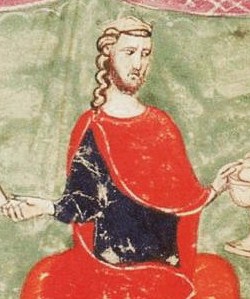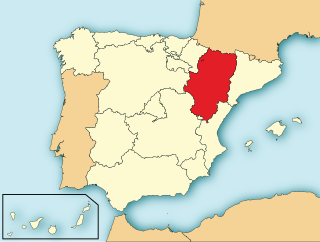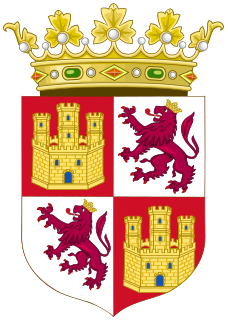Galceran de Requesens y Santa Coloma (before 1426 - 1465), a Catalan nobleman, was an enemy of the Barcelona city council (an oligarchic power group then known as La Biga, comprising the nobility and major merchants of the city), and was Governor of Mallorca. He was a son of Luis de Requesens y Relat (d. 1426), baron of Altafulla and La Nou de Gaià, both rural lands located in the Spanish province of Tarragona.

Catalonia is an autonomous community in Spain on the northeastern corner of the Iberian Peninsula, designated as a nationality by its Statute of Autonomy. Catalonia consists of four provinces: Barcelona, Girona, Lleida, and Tarragona. The capital and largest city is Barcelona, the second-most populated municipality in Spain and the core of the sixth most populous urban area in the European Union. It comprises most of the territory of the former Principality of Catalonia. It is bordered by France (Occitanie) and Andorra to the north, the Mediterranean Sea to the east, and the Spanish autonomous communities of Aragon to the west and Valencia to the south. The official languages are Catalan, Spanish, and the Aranese dialect of Occitan.
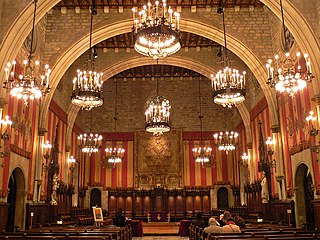
The Consell de Cent was a governmental institution of Barcelona. It was established in the 13th century and lasted until the 18th century.
Oligarchy is a form of power structure in which power rests with a small number of people. These people may be distinguished by nobility, wealth, family ties, education or corporate, religious, political, or military control. Such states are often controlled by families who typically pass their influence from one generation to the next, but inheritance is not a necessary condition for the application of this term.
He moved to the island of Menorca around 1439, because of disputes with the oligarchs of Catalonia since 1435, under King Alfonso V of Aragon.
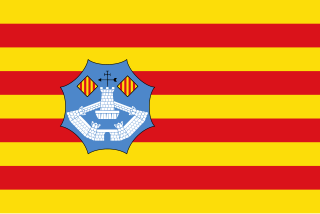
Menorca or Minorca is one of the Balearic Islands located in the Mediterranean Sea belonging to Spain. Its name derives from its size, contrasting it with nearby Majorca.

Alfonso the Magnanimous KG was the King of Aragon, Valencia, Majorca, Sardinia and Corsica, Sicily and Count of Barcelona from 1416, and King of Naples from 1442 until his death. He was one of the most prominent figures of the early Renaissance and a knight of the Order of the Dragon.
In December 1439 the king invested him as a baron of Molins de Rei and the Barcelona area known as Santa Creu de Olorda. He opposed the oligarchs with a pressure group of merchants and artisans known as La Busca. Forbidden to meet in the town of Barcelona, the Busca met outside the town, in Sabadell, Terrassa, Vilafranca del Penedès and Montcada.

Molins de Rei is a municipality located 18 km from Barcelona's city centre, in the comarca of Baix Llobregat in Catalonia, Spain. It is situated on the left bank of the Llobregat river, on the A-7 autopista from Valencia to La Jonquera and the main N-II road.
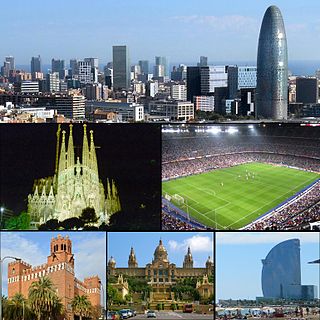
Barcelona is a city in Spain. It is the capital and largest city of the autonomous community of Catalonia, as well as the second most populous municipality of Spain. With a population of 1.6 million within city limits, its urban area extends to numerous neighbouring municipalities within the Province of Barcelona and is home to around 4.8 million people, making it the sixth most populous urban area in the European Union after Paris, London, Madrid, the Ruhr area and Milan. It is one of the largest metropolises on the Mediterranean Sea, located on the coast between the mouths of the rivers Llobregat and Besòs, and bounded to the west by the Serra de Collserola mountain range, the tallest peak of which is 512 metres high.

Sabadell is the fifth largest city in Catalonia, Spain. It is in the south of the comarca of Vallès Occidental and its joint capital, on the River Ripoll, 20 km (12 mi) north of Barcelona. Sabadell is located 190 m (620 ft) above sea level and is the co-capital of the comarca.
Acting as a royal agent, Lieutenant General of Catalonia, in November 1453 he suppressed the Barcelona Council. He had to go to clear these disputes and actions with King Alfonso V of Aragon, mainly residing near Naples, Italy since 1423, his estranged Spanish wife being till then a sort of royal representative of her husband king Alfonso, or governor of Catalonia, together with Alfonso's troublesome and restless brother, John, former prince consort of Navarre, later King John II of Aragon and the father of the later King Ferdinand II of Aragon and of the Navarrese inheritor of the kingdom, Prince Charles of Viana. In 1456 Alfonso V of Aragon, a.k.a. Alfonso I of Naples, awarded him feudal rights to the Italian towns of Trivento and Avellino.

Naples is the regional capital of Campania and the third-largest municipality in Italy after Rome and Milan. In 2017, around 967,069 people lived within the city's administrative limits while its province-level municipality has a population of 3,115,320 residents. Its continuously built-up metropolitan area is the second or third largest metropolitan area in Italy and one of the most densely populated cities in Europe.
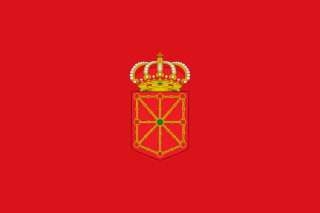
Navarre ; officially the Chartered Community of Navarre, is an autonomous community and province in northern Spain, bordering the Basque Autonomous Community, La Rioja, and Aragon in Spain and Nouvelle-Aquitaine in France. The capital city is Pamplona.

John II, called the Great or the Faithless, was the King of Navarre through his wife from 1425 and the King of Aragon in his own right from 1458 until his death. He was the son of Ferdinand I and his wife Eleanor of Alburquerque. John was also King of Sicily from 1458-1468.
Before dying in 1458, Alfonso granted the status of nobility to Galceran and to his brother Bernat de Requesens y de Santa Coloma, but the "Biga" group they represented disputed John II's succession to his brother Alfonso, claiming new and old laws implemented along the Catalan counties' history. The "Biga" had supported the unfortunate Prince Charles of Viana, half-brother of the later king Ferdinand II, as a candidate to inherit the Navarrese throne. John II also claimed the Navarrese throne, something unacceptable to the Navarrese, as his having been prince consort of Navarre did not confer the right to succession.
The defeat in 1461 of Charles, fighting against his father John, legal king of Aragon since 1458 on the death of his brother Alfonso V, led to the so-called capitulation of Vilafranca del Penedès and Charles's imprisonment by John, as well as to his premature death under suspicious circumstances.

Vilafranca del Penedès, or simply Vilafranca, is the capital of the comarca of the Alt Penedès in Catalonia, Spain. The Spanish spelling of the name, Villafranca del Panadés, is no longer in official use since 1982. It is situated in the Penedès Depression on the left bank of the Foix River, and on the main axis of communication from Barcelona to Tarragona and Valencia, served by a Rodalies Barcelona line 4 and by the AP-7 autopista as well as by the C-243 towards Sant Sadurní d'Anoia, and C-15 roads to Vilanova i la Geltrú and Igualada respectively.
Galceran and his wife Elisabeta Joan de Soler, from Valencia, had 13 children, many of them entrepreneurs, international merchants and members of the Aragonese nobility settled there. Galceran de Requesens was eventually made destitute and went to prison for 108 days before being exiled to Valencia, where he died in 1465.
